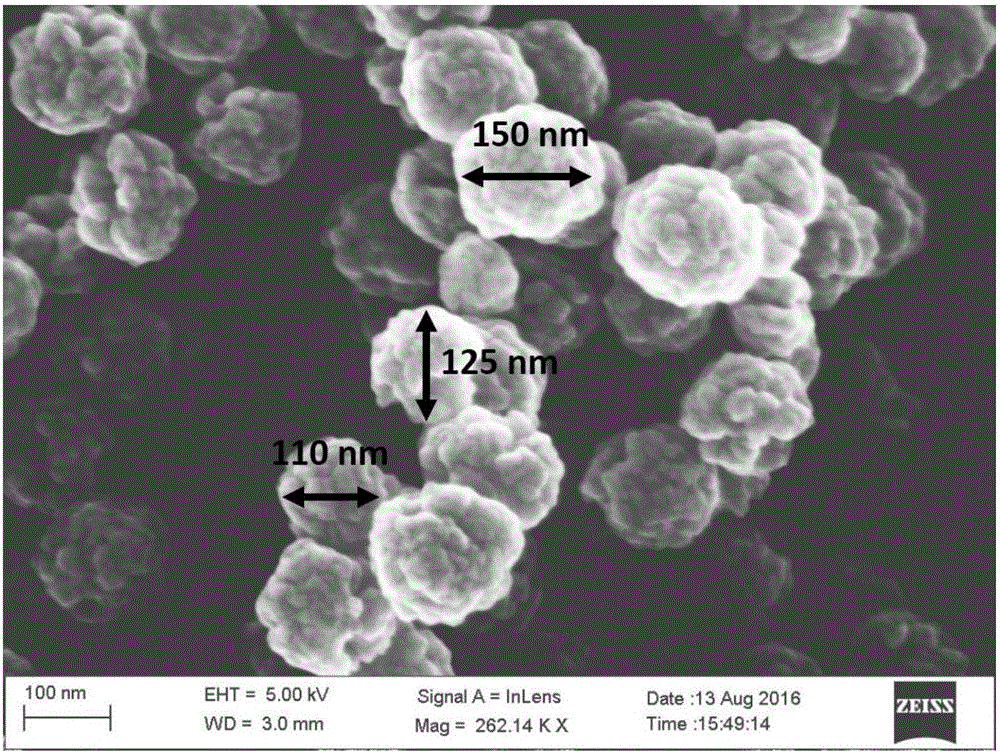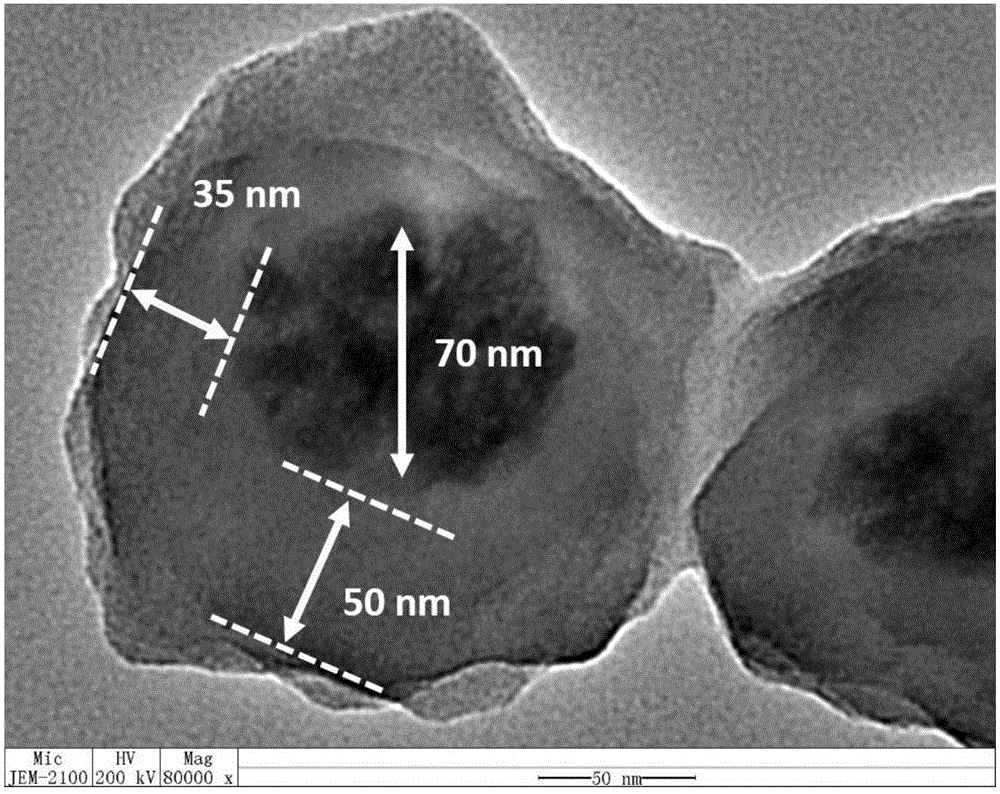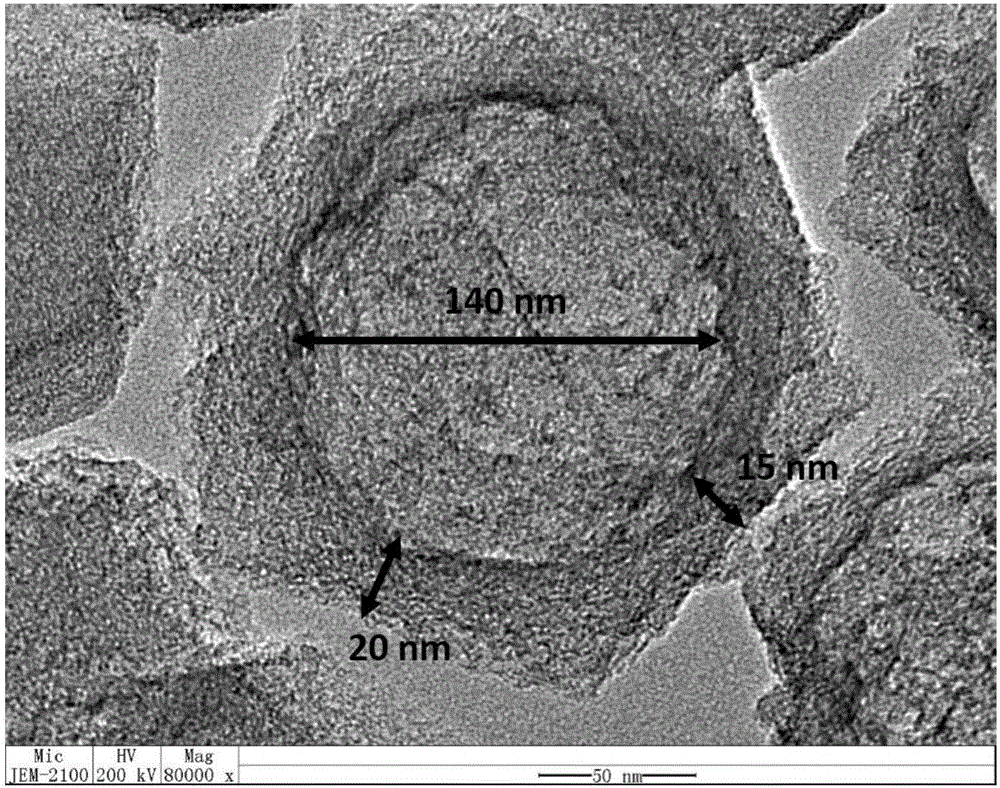Mono-dispersed nitrogen doped hollow carbon nano polyhedron and preparation method thereof
A nitrogen-doped, monodisperse technology, applied in the direction of nano-carbon, can solve the problems of inability to directly prepare hollow-structure carbon nanomaterials, and achieve the effect of maintaining polyhedral morphology, uniform nitrogen doping, and environmentally friendly preparation processes
- Summary
- Abstract
- Description
- Claims
- Application Information
AI Technical Summary
Problems solved by technology
Method used
Image
Examples
Embodiment 1
[0033] (1) Preparation of ZnO nanospheres
[0034] Add 40mL of 0.1mol / L zinc acetate aqueous solution and 200mL of 0.1mol / L triethanolamine aqueous solution into a 250mL Erlenmeyer flask, stir at room temperature for 30min, and then irradiate it in a water bath at 20℃ ultrasonically for 20min. Set 12h. ZnO nanospheres are obtained by centrifugal collection, washing, and vacuum drying.
[0035] (2) Preparation of ZnO@ZIF-8 precursor with core-shell structure
[0036] Add 40.0mg of ZnO nanospheres obtained in step 1) into a 40ml glass bottle containing a mixed solvent of DMF and water (32mL, volume ratio 3:1), and ultrasound for 10min at room temperature to fully diffuse, and then add 0.33g 2-formaldehyde After sonicating for 5 minutes, the glass bottle was tightly capped and placed in a 50°C oven for 6 hours. After the reaction, the product was centrifuged, washed, and vacuum dried to obtain a core-shell structure ZnO@ZIF-8 precursor.
[0037] (3) Preparation of monodisperse nitrogen...
Embodiment 2
[0042] (1) Preparation of ZnO nanospheres
[0043] Add 40mL of 0.1mol / L zinc acetate aqueous solution and 200mL of 0.2mol / L triethanolamine aqueous solution into a 250mL Erlenmeyer flask, stir at room temperature for 30min, and then irradiate it in a water bath at 50℃ ultrasonically for 20min, then statically Set 12h. ZnO nanospheres are obtained by centrifugal collection, washing, and vacuum drying.
[0044] (2) Preparation of ZnO@ZIF-8 precursor with core-shell structure
[0045] Add 40.0mg of ZnO nanospheres obtained in step 1) into a 40ml glass bottle containing a mixed solvent of DMF and water (32mL, volume ratio 3:1), and ultrasound for 10min at room temperature to fully diffuse, and then add 0.33g 2-formaldehyde After sonicating for 5 minutes, the glass bottle is tightly capped and placed in an oven at 70°C for 4 hours. After the reaction is completed, the product is centrifuged, washed, and vacuum dried to obtain a core-shell structure ZnO@ZIF-8 precursor.
[0046] (3) Prepa...
Embodiment 3
[0049] (1) Preparation of ZnO nanospheres
[0050] Add 40mL of 0.1mol / L zinc acetate aqueous solution and 200mL of 0.1mol / L triethanolamine aqueous solution into a 250mL Erlenmeyer flask, stir at room temperature for 30min, and then irradiate it in a water bath at 50℃ ultrasonically for 20min, then statically Set 12h. ZnO nanospheres are obtained by centrifugal collection, washing, and vacuum drying.
[0051] (2) Preparation of ZnO@ZIF-8 precursor with core-shell structure
[0052] Add 40.0mg of ZnO nanospheres obtained in step 1) into a 40ml glass bottle containing a mixed solvent of DMF and water (32mL, volume ratio 2:1), ultrasonically at room temperature for 10 minutes to fully diffuse, and then add 0.66g 2-formaldehyde After sonicating for 5 minutes, the glass bottle was tightly capped and placed in an oven at 50°C for 4 hours. After the reaction, the product was centrifuged, washed, and vacuum dried to obtain the core-shell structure ZnO@ZIF-8 precursor.
[0053] (3) Preparati...
PUM
| Property | Measurement | Unit |
|---|---|---|
| Particle size | aaaaa | aaaaa |
| Diameter | aaaaa | aaaaa |
Abstract
Description
Claims
Application Information
 Login to View More
Login to View More - R&D
- Intellectual Property
- Life Sciences
- Materials
- Tech Scout
- Unparalleled Data Quality
- Higher Quality Content
- 60% Fewer Hallucinations
Browse by: Latest US Patents, China's latest patents, Technical Efficacy Thesaurus, Application Domain, Technology Topic, Popular Technical Reports.
© 2025 PatSnap. All rights reserved.Legal|Privacy policy|Modern Slavery Act Transparency Statement|Sitemap|About US| Contact US: help@patsnap.com



